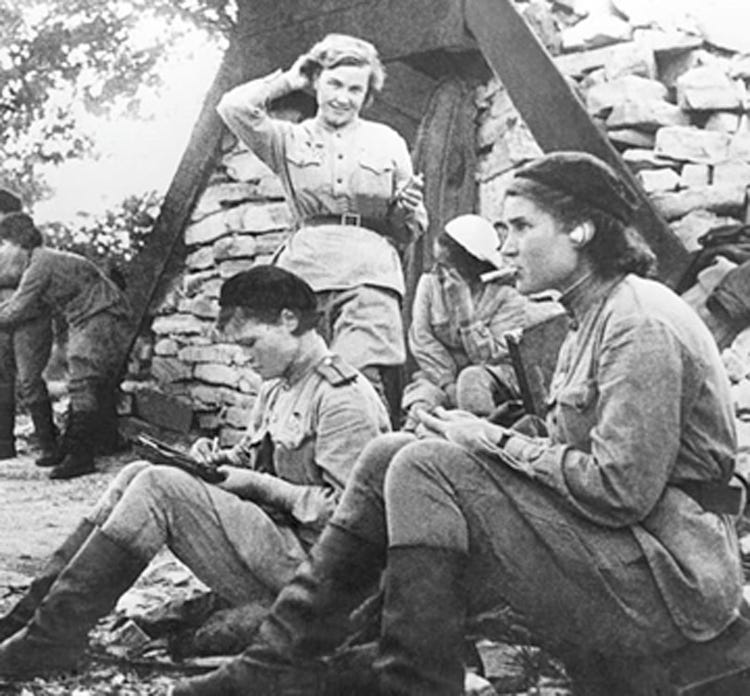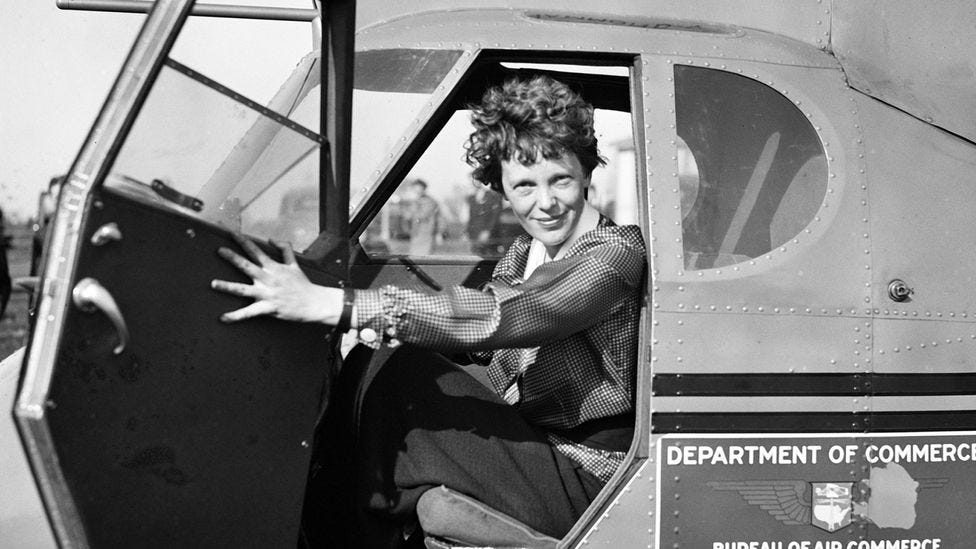How "The Night Witches" Helped Defeat the Nazis
A story from World War II you may not have heard
Hello!1
I am gearing up for a trip to Austin, Texas to attend the SXSW Conference next week… and that got me thinking about flying.
And that got me thinking about pilots… and March being Women’s History Month…and how I could combine the two for this week’s story.
When it comes to women and aviation history, Amelia Earhart might get the most attention.
She disappeared 87 years ago, and people are still speculating about what happened to her and trying to locate her plane.
She’s the woman I instantly associate with aviation history. That, and that she was also the first woman to wear slacks at Purdue University (perhaps a lesser known fun fact about her).
But there are other women from aviation history who aren’t as well known…like The Night Witches.
But who were the Night Witches?
I was curious…
The story of the Night Witches begins with a woman named Marina Raskova.
While Americans had Amelia Earhart, the Soviets had Marina Raskova.
Raskova was the most famous aviatrix2 in Russia during the 1930s.
In 1938, she became the first woman to be awarded the Hero of the Soviet Union medal, and she was also the first female navigator in the Soviet Air Force.
And as World War II raged on, Marina Raskova had an idea.
She had been receiving letters from women across the Soviet Union.
Women had lost their brothers, their sweethearts, and seen their villages and homes destroyed – and they wanted to help their country.
They wanted to be gunners and pilots.
Although women were effectively barred from combat at that time, Raskova used her fame and influence to lobby for them – even petitioning Joseph Stalin to let her form an all-female fighting squadron.
And in October 1941, with the Nazi Army advancing in the Soviet Union, Raskova received orders to establish a trio of all-female air squads.
The women who joined these squads faced many obstacles – from skepticism and sexism on the ground to grueling conditions and perilous missions in the sky.
But despite these obstacles, one of these squads – The 588th Night Bomber Regiment – became the most highly decorated unit in the Soviet Air Force.
The women of the 588th began their training in 1942.
They were young (ranging in age from 17 to 26) – but eager to learn.
Everyone in the squad was female, from the pilots to the mechanics.
The military wasn’t prepared for women pilots, and gave them meagre resources.
While male pilots were given radar, guns, and radios, the women had to make do with rudimentary tools such as rulers, pencils, and compasses.
They were issued hand-me-down uniforms (made for bulkier male soldiers) and ill-fitting boots.
And their uniforms weren’t the only things that were old.
The women had to fly Polikarpov P0-2 aircraft – two-seated, open cockpit biplanes that were designed for crop-dusting, not combat.
Even in 1942, these planes were obsolete.
Made from plywood with canvas stretched over them, the aircraft provided little protection for the women who would fly them – and would ignite instantly if hit by tracer bullets.
Their light planes couldn’t hold much either – only two bombs at a time.
The weight of the bombs meant the women had to fly at lower altitudes, making them much easier targets for the Germans.
Their greatest protection was the cover of night, but even then they were exposed to both enemy fire and freezing temperatures.
“When the wind was strong it would toss the plane,” said Nadezhda Popova, one of the most celebrated pilots of the 588th.
“In winter, when you’d look out to see your target better, you got frostbite. Our feet froze in our boots, but we carried on flying.”

As soon as night fell, the women would take to the skies.
Three planes would leave simultaneously.
Two would draw the searchlights and gunfire while the third plane dropped the bombs.
The pilots would kill their engines when they got near their target, gliding over it making a light ‘whooshing’ noise that resembled the sound of a sweeping broom.
That led to German soldiers referring to them as ‘Nachthexen’ or ‘Night Witches.’
As soon as the pilots completed their run, they’d land at their temporary base to refuel, take on two more bombs, and return to the sky, completing as many as 18 runs in a single night.
The women of the 588th were tremendously effective – and both feared and hated by the enemy.
In fact, any German airman who downed one was automatically awarded the prestigious Iron Cross medal.
The Germans credited the Night Witches’ success to pills and treatments that gave them special night vision powers.
“That was nonsense, of course,” said Popova.
“What we did have were clever, educated, very talented girls.”
The Night Witches warmly adopted the moniker the Germans gave them.
They embraced who they were as fighters, and who they were as women, following 12 commandments set out by Marina Raskova.
The first was: “Be proud you are a woman.”
The Night Witches were tough, disciplined fighters in the sky, but in their downtime did needlework, danced, and decorated their planes.
They even used their navigation pencils as eyeliner and lipstick.
By the end of the war, they had flown in 30,000 bombing raids, and dropped 23,000 tons of bombs on Nazi targets.
They are credited with damaging or destroying 17 river crossings, 9 railways, 2 railway stations, 26 warehouses, 12 fuel depots, 176 armored cars, 86 prepared firing positions, and 11 searchlights.
They also made 155 supply drops of food and ammunition to Soviet forces.
They lost 30 pilots during the war, and 23 pilots were awarded the title of Hero of the Soviet Union.
Raskova died on the front line January 4, 1943, and was given the first state funeral of World War II, and her ashes were buried in the Kremlin.
Despite being the most highly decorated unit in the Soviet Air Force during the war, many in the Soviet military failed to give the women the respect and credit they earned.
The Night Witches regiment was disbanded six months after the end of World War II.
They weren’t even included in the victory-day parade in Moscow because, it was decided, their planes were too slow.3
One more thing…
Curious about other women from aviation history?
I (literally) couldn’t put this book by Keith O’Brien down when I started reading it.
Get Curious about…International Women’s Day
This is your PSA that the United Nations theme for International Women’s Day is “Invest in Women: Accelerate Progress.”
You might see another unofficial International Women’s Day campaign asking you to “inspire inclusion” by making a love heart with your hands.
This symbol is great to do at a Taylor Swift concert, but is unlikely to move the dial on inequality.
In case you’re wondering what I’m talking about, check out this piece I wrote last year after I saw the same outfit telling us to “embrace equity” by hugging ourselves on International Women’s Day.
As my dad (and Charlie Brown) would say, Good Grief!
Recent Work and Writing
Speaking of my dad, he used to say, “You’re Always Thinking, Beth!”
He wasn’t wrong.
I do a lot of thinking, and this week it hasn’t been all about the Willy Wonka debacle (though those memes are the gifts that keep giving).
Here’s what else has been on my mind…
What’s Holding Women Back? — Is it women’s mindsets that hold them back? Or something else? I investigate…
Enough of the Ghosting — It may be more common these days, but that doesn’t mean it’s OK.
Communication Wonders & Blunders — Find out which communication moments from CEOs, politicians, entertainers, and companies caught my attention in January — and what we can learn from them.
And stay tuned for February’s high and low moments.
How Can I Help?
I’ll keep saying it: Communication matters.
If you want to improve your communication (and get all the good things that come with that), I’m your gal.
So many companies could reap massive rewards – from performance and culture to retention and engagement – by improving their communication.
So, if you know someone who could benefit from some help (as even the most seasoned leaders do), please get in touch and check out my website for more information.
You can also see my Top 10 list of what I can (and can’t) do for you here.
And if you see any communication examples (the good, the bad, and the ugly) that you think are worth analyzing or sharing, please send them my way!
Stay Curious!
-Beth
Apologies for any names I’ve mispronounced in the audio version of this story. It’s not for lack of trying!
I would have called her an “aviator” - but an article I read called her an “aviatrix”, so I’m using their word. Apparently “Girl Hawk” was another term used to describe women aviators back in the day…as well as “ladybirds”, “flying flappers”, and “fly girls”
Hello, irony!





















Excellent article. Loved hearing you read to me also.